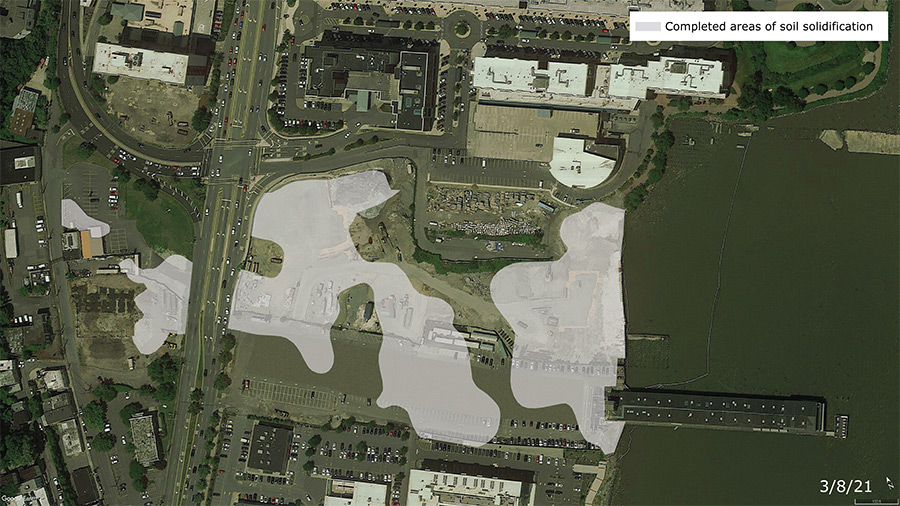Soil Cleanup Under Tents
Many of the remaining cleanup activities at the site (soil solidification, stockpile management, and earth moving) were conducted under tents to reduce emissions into the air as much as possible. These large, specialized structures were fitted with air handling equipment that allowed for work to be safely conducted within them.
Tent Movement
- Two tents moved across the site over the treatment areas. When treatment was finished in an area, the tent was moved by crane to the next area.
- Because of physical interferences and safety, soil remediation in portions of the remaining area to be treated was performed outside of a tent. Vapor mitigation techniques (see below) were used in these un-tented areas of soil solidification.

Air Treatment for Tents
- During soil solidification in tents, air was pulled out of the tent for treatment in large external carbon units.
- Treated air was released above the ground through a stack on the carbon unit.
- Carbon units were replaced periodically before carbon inside the unit came close to absorbing all the contaminants it could.
- Air in the tent was replaced approximately 6 times per hour for proper ventilation and safety.
- Technicians monitored air emissions from the stack and sampled air inside the unit to determine when carbon needed to be replaced.
- Carbon treatment was more than 95% effective (permit limits) in removing site-related airborne contaminants before release through the stack.
- Work was being completed in accordance with a New Jersey Department of Environmental Protection (NJDEP) air permit equivalency. To confirm that emissions met the NJDEP's requirements, VOC emissions from the carbon units were sampled three times - 1) during the first month of operation, 2) when working in a highly-contaminated area, 3) when carbon in the unit had absorbed at least 50% of the contaminants it could contain.

Air Monitoring
During the work under the tents, Honeywell, with EPA oversight, continued to implement an air monitoring program.
Vapor Mitigation for Work Outside Tents
Vapor mitigation techniques were used for soil solidification activities outside tents. These mitigation measures included:
- Minimize area of disturbed soil - Excavated areas were kept small (20 feet by 20 feet), completed, and covered with gravel before work moved to the next location.
- Posi-Shell - Posi-shell is a natural clay-based mortar more durable than foam that was sprayed continuously to manage odors and at the end of each workday. Portland cement was mixed in to help it set up faster and increase the effectiveness of the spray.
- Plastic poly sheeting - When appropriate and safe for workers, plastic sheeting was used to cover stockpiles. Sandbags were used to secure the plastic sheeting.

